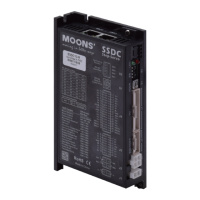9
Rev. 1.0
10/22/2018
SSDC-R/C Hardware Manual
400-820-9661
RS-485 network connection
Multiple –R model drive network can be built via dual RS-485 communication port by
daisy chain cable or network cable provided.
RS-485 Four-wire Configuration
RS-485 four-wire system utilize separate transmit and receive wires. One pair of wires
connect the host’s transmit signals(TX+/TX-) to each drive’s RX+/RX- receive
terminals. The other pair connects the drive’s TX+/TX- terminals to the host’s receive
signals. A logical ground terminal is provided on each drive and can be used to keep all
the drives at the same ground potential. The first drive’s logical GND of the RS-485 bus
must connect to host’s ground.
Four-wire Connection
Connect the drive’s RX+ to the TX+ terminal of the host controller, and connect the
drive’s RX- to the TX- terminal of the host controller. Connect the drive’s TX+ to the
RX+ terminal of the host controller, and connect the drive’s TX- to the RX- terminal of
the host controller.
Connect the drive’s GND and the host’s GND to a same ground.
RS-485 Tow-wire Configuration
In a two-wire system, the data transmitting and receiving use a same cable. The host
must stop its transmitting before receiving data. That means the host must stop transmit
data before drive begins to answer a query which just come from the host, otherwise the
host cannot receive any data witch sent from a drive. There is a transmit delay parameter
that can be adjusted to compensate for a host that is slow to disable its transmitter. This
adjustment can be set over the network using the TD command, it also can be set by
using the Step-Servo Quick Tuner software. Users can set a shorter transmit delay in a
four-wire system.
Two-wire connection
The RX+ and TX+ of the drive connect to the host’s + in parallel. The RX- and TX- of the
drive connect to the host’s - in parallel. Connect the drive’s GND and the host’s GND
to a same ground.

